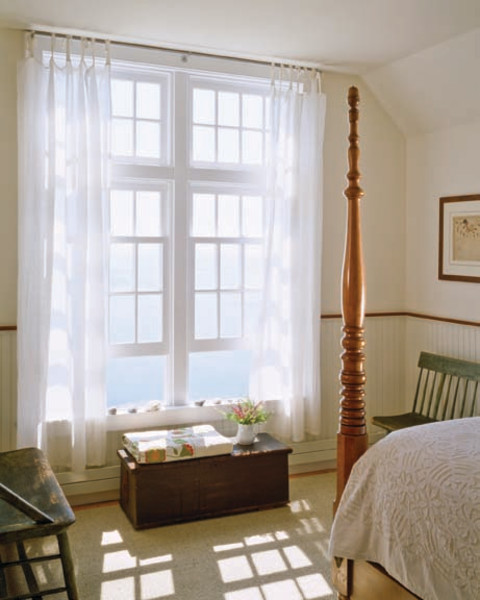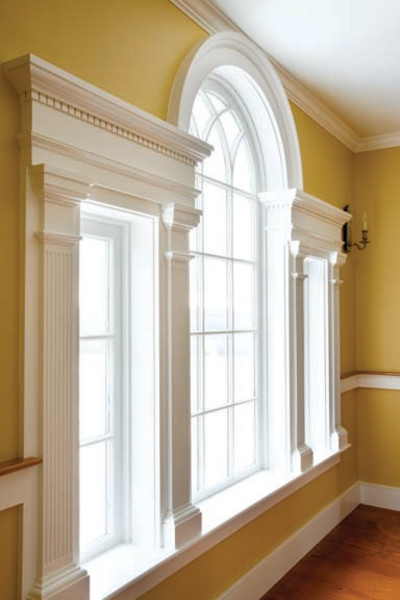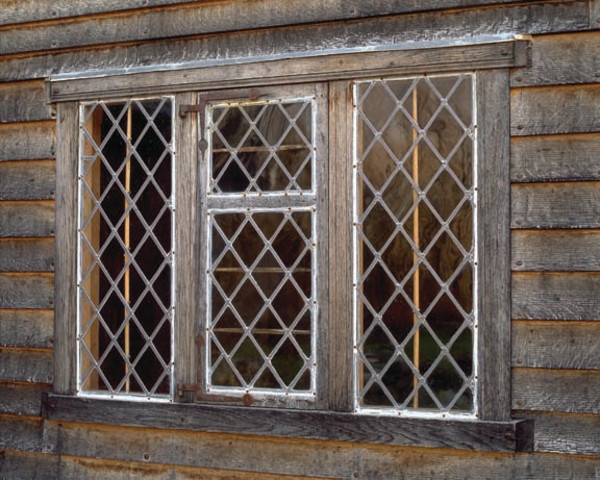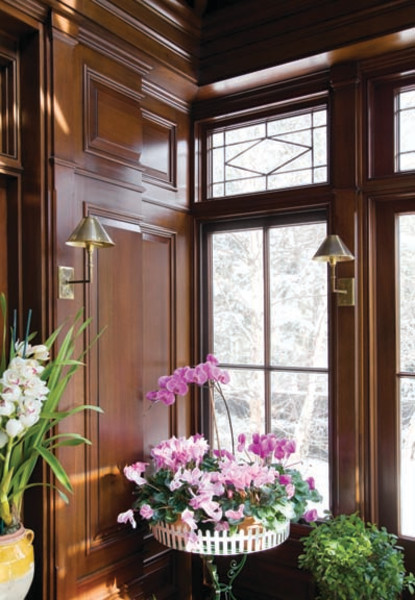
Connecticut-based firm Whitten Architects incorporated a transom over these six-over-six sash windows. (Photo: Brian Vanden Brink)
They are mostly clear but often seen, and they play a major role in a period-appropriate look. Ideally, windows appeal visually and operate efficiently while enhancing a cohesive architectural whole. If certain elements are out of step with an informing time period, however, the illusion of “old” can be lost—a particularly worrying outcome considering a window’s pervasiveness as a structural element.
In comparison to its straightforward purpose, a window’s components are intricate and its materials vary. Unless the goal is repair or exact reproduction, there is no one single equation governing the look of a new-old window. Unique combinations of design elements are possible, and homeowners who understand the historical reasoning behind their options are best equipped to navigate through window rights and wrongs.
In Proportion
Before tackling the window itself, architects first consider a home’s percentage of glazed area. “Determining how much of a building’s façade is taken up by windows greatly determines the character of a building,” explains Michigan-based architect Marc Rueter. The size of handblown panes and their availability in the United States affected proportions over time. Glazing allotment in a Greek Revival is much smaller than in a Victorian or Craftsman-style house, for example.
Another consideration affecting historical accuracy is the placement of windows in a building. “Modern houses are designed from the inside out based on a client’s lifestyle,” continues Rueter. In comparison, he adds, Greek Revival features were positioned in accordance with the style’s “perfect temple” ideal, whereas early frame construction necessitated windows arranged directly above one another in multiple stories. As a general rule, throughout the nation’s past, construction techniques and architectural authenticity—not lifestyle requirements—determined window placement.
Addressing the proportion of a window itself is next in a designer’s decision-making progression. A window’s height and width are governed by a 2:1 ratio, explains architect Sandy Vitzthum of Sandra Vitzthum Architects in Vermont. She notes that, for example, windows in the South are often taller than 2:1, a telltale characteristic that makes a structure look Southern. “It’s important to know the proportions in a particular area,” she explains.

Connor Homes designed this Palladian window for a home in New York using classical detailing such as dentil molding and fluted pilasters. (Photo: Eric Roth)
General Guidelines
The extent of a new-old window’s period appropriateness varies depending on a home’s location and its owner’s goals. Customization tactics and historical knowledge vary even among architects and designers, points out Vitzthum: “It’s really important for homeowners to know their options in terms of customizing a window order so they know the right questions to ask. Even small order adjustments to stock windows can make a big difference when it comes to historical accuracy.”
Many window manufacturers have incorporated a variety of upgrades and options into their new “historic” windows. Marvin, for example, offers single glazing, authentic divided lights, and custom wood sills, as well as wood screens and storm windows. Depending on the level of preservation required, there are also specialty manufacturers and millwork companies that replicate original designs exactly or even piece together clues to re-create size and muntin profiles when originals no longer exist.
Glass type is a vital consideration: Designers desiring true authenticity select handblown sheet glass from restoration glass companies like Bendheim. Depending on the origin and craft method, this antique glass is also known as crown or cylinder glass and is the only accurate representation of glass produced during the eighteenth to early twentieth centuries. Shaped by hand, it is characterized by waviness and small imperfections—homeowners worried about visibility should inquire about light distortion levels.
Maryland-based architect Anne Decker, in reviewing her do’s and don’ts of new “historic” windows, summarizes: “It’s key to do an all-wood window with wood jambs.” If a window will ultimately be painted, Decker recommends fir or pine. Mahogany, typically stained, is especially appropriate for larger windows and doors. “Pine can shrink and warp with extreme weather changes; sometimes muntins can actually separate from a window,” she says. “Mahogany is a much more stable wood for anything oversized.”
Small in stature but important in a window’s overall appearance is hardware. Many manufacturers offer upgraded lines, notes Decker, who recommends oil-rubbed bronze or unlacquered brass for historical authenticity. Hardware for casements should not be overlooked: “We tend to use a push-out handle for in-swing and out-swing casements versus a crank. The push-out is very period appropriate,” she says.
Early Construction Techniques

Maurer & Shepherd Joyners makes historically accurate windows, such as this seventeenth-century lattice window with diamond panes.
How a window was originally made and what types of materials were available inform correct selection. Hap Shepherd, co-owner of Maurer & Shepherd Joyners, explains that the country’s earliest versions were lead came casement windows, an improvement over oilcloths reinforced by wood shutters. “Back then, colonists used pre-made lead with glass diamonds in sheet form from England. Then they would turn around and make their own frames,” he says. These sheets were later crafted into double-hungs.
Shepherd’s Connecticut-based company specializes in preservation and millwork and is known for crafting historically accurate windows, from eighteenth-century twelve-over-twelves to more ornate Palladian windows. Noting that, in any house, windows may have been replaced one or more times throughout the years, Shepherd uses his knowledge of early American construction techniques to investigate not only the original windows’ sizes but also their muntin profiles.
His firm places reclaimed cylinder glass into true divided lights—individual panes of glass between muntin bars—mirroring historic construction. Another detail his firm prioritizes is the wood’s finished texture. “There was no sandpaper in the eighteenth century,” he points out. “All of our surfaces are made by machine and then hand-planed. When the wood is painted, you can see a slight ripple.”
Efficiency and Maintenance

Thin muntins in this two-over-two window offer a historical look. (Photo: Eric Roth)
Jeff Hoffman, an architectural consultant with Marvin, is well versed in window options that blend older aesthetics with a dose of high tech. Individual panes of glass between muntin bars can be mimicked using simulated divided light (SDL), whereby grid work is applied to both sides of a sill. Spacer bars between the two glass layers complete the illusion of individual panes even though the window is double-glazed.
“Historic districts are typically concerned about keeping the same daylight openings, and SDL maintains these openings with the upgrade of insulated glass with the latest low-E technology,” says Hoffman. SDL also works with tri-pane glass; however, this option is rarely approved in historic districts and an uncommon choice for historical applications.
“Another consideration is the lack of weatherstripping in older windows,” Hoffman adds. “Our stripping performs, but is concealed as much as possible.”
Aluminum cladding is increasingly used for window exteriors when maintenance is an issue. Marvin uses a commercial-grade aluminum that “simulates painted wood and also exhibits much cleaner, crisper edges than vinyl, which can’t be machined to high tolerances,” says Hoffman. He references a recent project in St. Paul, Minnesota, with seven stories in a strict historic district. “We used all wood for the first and second stories, but aluminum cladding was allowed on floors three through seven.”
When selecting period-appropriate windows for a new-old house, addition, or renovation, no consideration is too small. Careful planning and research ensure that the sum of a window’s parts communicates the craftsmanship of past eras well into the future.
Looking for more inspiration? Upgrade the antique window hardware in your old home.







